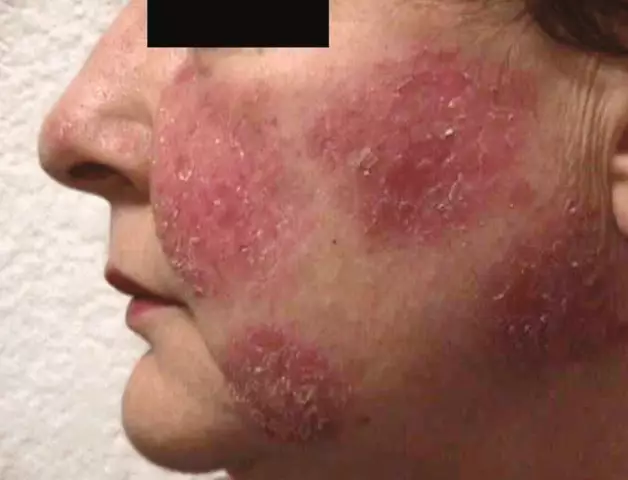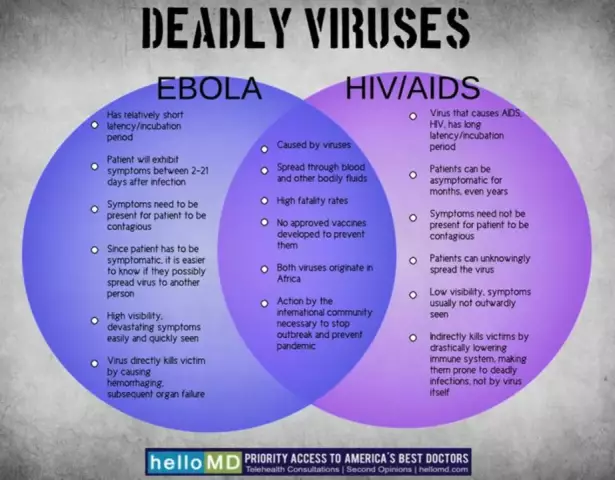- Author Rachel Wainwright [email protected].
- Public 2023-12-15 07:39.
- Last modified 2025-11-02 20:14.
Pemphigus
Brief description of the disease
Pemphigus is a severe skin disease that is manifested by the formation of blisters on the surface of the skin and mucous membranes. This process is due to the stratification of the epithelium and is characterized by a tendency to spread rapidly due to the fusion of several lesions. The causes of pemphigus are not fully understood, which is why the treatment of the disease is often ineffective. Pemphigus is especially dangerous in children. In the absence of adequate treatment, it can lead to serious complications and even death of the child, although modern medical technologies can reduce the number of deaths to a minimum. However, children of any age are rarely affected. Much more often, the viral pemphigus makes itself felt in persons aged 40 to 60 years.
Pemphigus symptoms
True pemphigus begins with the appearance of blisters on the skin and mucous membranes. They reach the size of a walnut and often burst, releasing clear or bloody contents. Ulceration forms on the skin after rupture. There have also been cases where the blisters did not burst, but subsided, leaving behind an itchy crust.
Seborrheic pemphigus manifests itself differently. Bubbles in this shape are usually small. They are not prone to tearing and most often simply shrink to form a greyish-yellow crust.
Viral pemphigus is a disease that is caused by the Coxsackie virus. It is characterized by rashes on the toes and hands, soles and palms. The blistering process is painful, accompanied by a febrile condition and ulceration of the oral mucosa.
Pemphigus treatment
Due to the fact that the etiology of the disease is unknown, the treatment process is rather complicated and often does not lead to the expected effect. Nevertheless, self-medication is unacceptable, since over time the disease develops and affects more and more new areas of the skin, leading to disruptions in the work of internal organs and, quite possibly, death of the patient.
If you are diagnosed with pemphigus, treatment is based on the use of hormones both internally and externally. Hormones are prescribed with an eye to vital signs and possible contraindications are rarely taken into account, since complications of pemphigus can lead to fatal consequences. For this reason, even with the normalization of the patient's condition, the daily dose of hormones is reduced gradually and very carefully until the minimum dose necessary to maintain a stable remission is reached.
Good results can be achieved by combining hormones with cytostatic and immunosuppressive drugs such as azathioprine, methotrexate and sandimmune. It should be borne in mind that these funds have individual tolerance and should be used with the greatest care.
When pemphigus is diagnosed, the disease is treated with the help of various additional methods, in particular, hemosorption and plasmapheresis, that is, procedures aimed at purifying the blood. The positive effect is achieved by removing immune complexes, immunoglobulins and other disease-causing components from the blood. Photochemotherapy is also aimed at cleansing the blood from toxic substances, which consists in inactivating blood cells with ultraviolet irradiation in combination with G-methoxypsoralen.
Potassium and calcium preparations are usually used as prophylactic agents.
Pemphigus in children
In the case of children, lesions of the skin and mucous membranes are especially dangerous, which is associated with the insufficiently high efficiency of the protective mechanisms of the child's body. Note that pemphigus in newborns is extremely rare. Usually, the disease progresses in children aged 5-7 years, with girls getting sick more often than boys.
The symptoms of pemphigus are the same as in adults - the appearance of blisters of different sizes in the face, trunk and extremities, followed by their rupture or desiccation. Itching and other unpleasant sensations are practically absent. With timely and adequate treatment, persistent remission occurs quickly.
Malignant pemphigus in children is rare, but is accompanied by severe consequences - weight loss, asthenia, the appearance of secondary infections, septic fever and complications in the kidneys, lungs and cardiovascular system.
Any methods of treatment used in relation to children should be used with extreme caution, especially with regard to the use of hormones and cytostatic drugs, since individual intolerance is often observed to them.
YouTube video related to the article:
The information is generalized and provided for informational purposes only. At the first sign of illness, see your doctor. Self-medication is hazardous to health!






